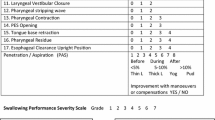Abstract
The aim of this prospective, observational study was to evaluate the effectiveness of a simple endoscopic method for scoring swallowing function after treatment of advanced head and neck cancer patients. A prospective, observational study was conducted involving 60 patients who had undergone surgery or chemoradiation for advanced head and neck cancer. Endoscopic score of swallowing function, penetration aspiration scale (PAS) score measured by videofluorography, and functional oral intake scale (FOIS) score were recorded, and their correlations were examined. There was a positive correlation between endoscopic and PAS scores. Patients with endoscopic scores of 4 points or more had significantly higher PAS scores and lower FOIS scores than those with scores of 3 points or less. These positive correlations were found only in patients who underwent surgery, and not those who received chemoradiation. This study showed the effectiveness of the simple endoscopic method for scoring swallowing function in patients after surgery for advanced head and neck cancers.




Similar content being viewed by others
Data Availability
The datasets analyzed during the current study are available from the corresponding author on reasonable request.
References
Manikantan K, Khode S, Sayed SI, Roe J, Nutting CM, Rhys-Evans P et al (2009) Dysphagia in head and neck cancer. Canc Treat Rev 35(8):724–732
Langmore SE, Schatz K, Olsen N (1988) Fiberoptic endoscopic examination of swallowing safety: a new procedure. Dysphagia 2:216–219
Tohara H, Saitoh E, Mays KA, Kuhlemeier K, Palmer JB (2003) Three tests for predicting aspiration without videofluorography. Dysphagia 18(2):126–134
Hyodo M, Nishikubo K, Hirose K (2010) New scoring proposed for endo- scopic swallowing evaluation and clinical significance. Nihon Jibiinkoka Gakkai Kaiho 113(8):670–678
Chiba Y, Sano D, Ikui Y, Nishimura G, Yabuki K, Arai Y et al (2018) Predictive value of the hyodo score in endoscopic evaluation of aspiration during swallowing. Auris Nasus Larynx 45(6):1214–1220
Kumai Y, Miyamoto T, Matsubara K, Samejima Y, Yamashita S, Ando Y et al (2019) Assessment of oropharyngeal swallowing dysfunction in myasthenia gravis patients presenting with difficulty in swallowing. Auris Nasus Larynx 46(3):390–396
Sakamoto T, Horiuchi A, Makino T, Kajiyama M, Tanaka N, Hyodo M (2016) Determination of the cut-off score of an endoscopic scoring method to predict whether elderly patients with dysphagia can eat pureed diets. World J Gastrointest Endosc 8(6):288–294
Imaizumi M, Suzuki T, Matsuzuka T, Murono S, Omori K (2019) Low-risk assessment of swallowing impairment using flexible endoscopy without food or liquid. Laryngoscope 129(10):2249–2252
Kumai Y, Miyamoto T, Matsubara K, Samejima Y, Yoshida N, Baba H et al (2019) Determining the efficacy of the chin-down maneuver following esophagectomy with fiberoptic endoscopic evaluation of swallowing. Arch Phys Med Rehabil 100(6):1076–1084
Imaizumi M, Suzuki T, Ikeda M, Matsuzuka T, Goto A, Omori K (2020) Implementing a flexible endoscopic evaluation of swallowing at elderly care facilities to reveal characteristics of elderly subjects who screened positive for a swallowing disorder. Auris Nasus Larynx 47(4):602–608
Fujiki M, Sakuraba M, Miyamoto S, Hayashi R (2016) Predictive factors of dysphagia after lateral and superior oropharyngeal reconstruction with free flap transfer. J Surg Oncol 113(2):240–243
Ohkoshi A, Ogawa T, Nakanome A, Ishida E, Ishii R, Kato K et al (2018) Predictors of chewing and swallowing disorders after surgery for locally advanced oral cancer with free flap reconstruction: a prospective, observational study. Surg Oncol 39(2):77–81
Eisbruch A, Lyden T, Bradford CR, Dawson LA, Haxer MJ, Miller AE et al (2002) Objective assessment of swallowing dysfunction and aspiration after radiation concurrent with chemotherapy for head-and-neck cancer. Int J Radiat Oncol Biol Phys 53:23–28
Rosenbek JC, Robbins JA, Roecker EB et al (1996) A penetration-aspiration scale. Dysphagia 11:93–98
Kalavrezos N, Bhandari R (2010) Current trends and future perspectives in the surgical management of oral cancer. Oral Oncol 46(6):429–432
Dziewas R, Warnecke T, Olenberg S, Teismann I, Zimmermann J, Kramer C et al (2008) Towards a basic endoscopic assessment of swallowing in acute stroke-development and evaluation of a simple dysphagia score. Cerebrovasc Dis 26(1):41–47
Newman LA, Vieira F, Schwiezer V, Samant S, Murry T, Woodson G et al (1998) Eating and weight changes following chemoradiation therapy of advanced head and neck cancer. Arch Otolaryngel Head Neck Surg 124:589–592
Ishii R, Kato K, Ogawa T, Sato T, Nakanome A, Ohkoshi A et al (2018) Poor oral intake causes enteral nutrition dependency after concomitant chemoradiotherapy for pharyngeal cancers. Eur Arch Otorhinolaryngol 275(6):1607–1611
Brown JS, Barry C, Ho M, Shaw R (2016) A new classification for mandibular defects after oncological resection. Lancet Oncol 17(1):e23-30
Funding
This work was supported in part by Grants-in-Aid for Scientific Research from JSPS Grant No. 19K18720.
Author information
Authors and Affiliations
Corresponding author
Ethics declarations
Conflict of interest
The authors declare that they have no conflict of interests.
Human or Animal Rights
All procedures performed in studies involving human participants were in accordance with the ethical standards of the Tohoku University School of Medicine research committee (Number 2014-1-274) and with the 1964 Helsinki declaration and its later amendments or comparable ethical standards.
Additional information
Publisher's Note
Springer Nature remains neutral with regard to jurisdictional claims in published maps and institutional affiliations.
Rights and permissions
About this article
Cite this article
Ohkoshi, A., Ogawa, T., Kato, K. et al. Simple Endoscopic Method of Scoring Swallowing Function After Treatment in Advanced Head and Neck Cancer Patients. Indian J Otolaryngol Head Neck Surg 74, 265–271 (2022). https://doi.org/10.1007/s12070-020-02307-9
Received:
Accepted:
Published:
Issue Date:
DOI: https://doi.org/10.1007/s12070-020-02307-9




